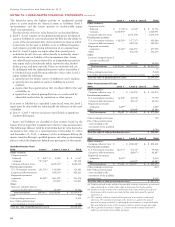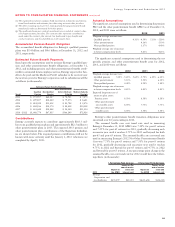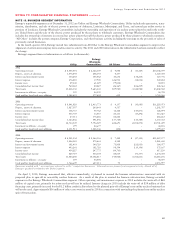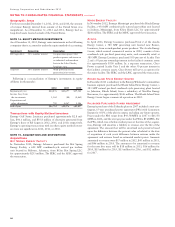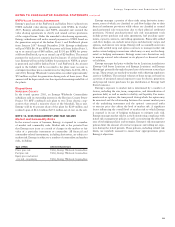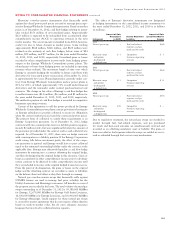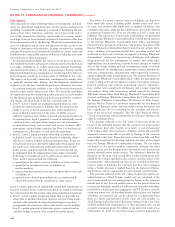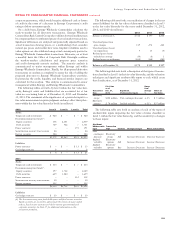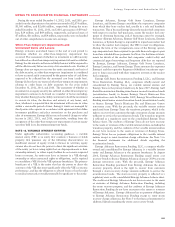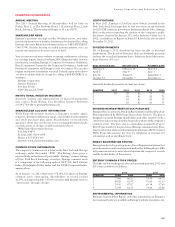Entergy 2012 Annual Report Download - page 104
Download and view the complete annual report
Please find page 104 of the 2012 Entergy annual report below. You can navigate through the pages in the report by either clicking on the pages listed below, or by using the keyword search tool below to find specific information within the annual report.Entergy Corporation and Subsidiaries 2012
NOTES TO CONSOLIDATED FINANCIAL STATEMENTS continued
Fair Values
The estimated fair values of Entergy’s financial instruments and deriv-
atives are determined using bid prices, market quotes, and financial
modeling. Considerable judgment is required in developing the esti-
mates of fair value. Therefore, estimates are not necessarily indica-
tive of the amounts that Entergy could realize in a current market
exchange. Gains or losses realized on financial instruments other than
those instruments held by the Entergy Wholesale Commodities busi-
ness are reflected in future rates and therefore do not accrue to the
benefit or detriment of shareholders. Entergy considers the carrying
amounts of most financial instruments classified as current assets and
liabilities to be a reasonable estimate of their fair value because of the
short maturity of these instruments.
Accounting standards define fair value as an exit price, or the price
that would be received to sell an asset or the amount that would be paid
to transfer a liability in an orderly transaction between knowledge-
able market participants at the date of measurement. Entergy and the
Registrant Subsidiaries use assumptions or market input data that mar-
ket participants would use in pricing assets or liabilities at fair value.
The inputs can be readily observable, corroborated by market data,
or generally unobservable. Entergy and the Registrant Subsidiaries
endeavor to use the best available information to determine fair value.
Accounting standards establish a fair value hierarchy that priori-
tizes the inputs used to measure fair value. The hierarchy establishes
the highest priority for unadjusted market quotes in an active market
for the identical asset or liability and the lowest priority for unobserv-
able inputs. The three levels of the fair value hierarchy are:
n Level 1 - Level 1 inputs are unadjusted quoted prices in active
markets for identical assets or liabilities that the entity has the
ability to access at the measurement date. Active markets are
those in which transactions for the asset or liability occur in
sufficient frequency and volume to provide pricing information on
an ongoing basis. Level 1 primarily consists of individually owned
common stocks, cash equivalents (temporary cash investments,
securitization recovery trust account, and escrow accounts), debt
instruments, and gas hedge contracts. See Note 1 to the financial
statements for a discussion of cash and cash equivalents.
n Level 2 - Level 2 inputs are inputs other than quoted prices
included in Level 1 that are, either directly or indirectly, observ-
able for the asset or liability at the measurement date. Assets are
valued based on prices derived by independent third parties that
use inputs such as benchmark yields, reported trades, broker/
dealer quotes, and issuer spreads. Prices are reviewed and can
be challenged with the independent parties and/or overridden
by Entergy if it is believed such would be more reflective of fair
value. Level 2 inputs include the following:
n quoted prices for similar assets or liabilities in active markets;
n quoted prices for identical assets or liabilities in
inactive markets;
n inputs other than quoted prices that are observable for the asset
or liability; or
n inputs that are derived principally from or corroborated by
observable market data by correlation or other means.
Level 2 consists primarily of individually-owned debt instruments or
shares in common trusts. Common trust funds are stated at estimated
fair value based on the fair market value of the underlying investments.
n Level 3 - Level 3 inputs are pricing inputs that are generally less
observable or unobservable from objective sources. These inputs
are used with internally developed methodologies to produce
management’s best estimate of fair value for the asset or liability.
Level 3 consists primarily of derivative power contracts used as
cash flow hedges of power sales at merchant power plants.
The values for power contract assets or liabilities are based on
both observable inputs including public market prices and inter-
est rates, and unobservable inputs such as implied volatilities, unit
contingent discounts, expected basis differences, and credit adjusted
counterparty interest rates. They are classified as Level 3 assets and
liabilities. The valuations of these assets and liabilities are performed
by the Entergy Wholesale Commodities Risk Control group and sent
to the Entergy Wholesale Commodities Back Office and Entergy
Nuclear Finance groups for evaluation. The primary functions of the
Entergy Wholesale Commodities Risk Control Group include: gath-
ering, validating and reporting market data, providing market and
credit risk analyses and valuations in support of Entergy Wholesale
Commodities’ commercial transactions, developing and adminis-
tering protocols for the management of market and credit risks,
implementing and maintaining controls around changes to market
data in the energy trading and risk management system, reviewing
creditworthiness of counterparties, supporting contract negotiations
with new counterparties, administering credit support for contracts,
and managing the daily margining process. The primary functions of
the Entergy Wholesale Commodities Back Office are managing the
energy trading and risk management system, forecasting revenues,
forward positions and analysis, performing contract administra-
tion, market and counterparty settlements and revenue reporting
and analysis along with maintaining related controls for Entergy
Wholesale Commodities. Both Entergy Wholesale Commodities Risk
Control and Entergy Wholesale Commodities Back Office report to
the Entergy Wholesale Commodities VP, Finance & Risk Group.
Entergy Nuclear Finance is primarily responsible for the financial
planning of Entergy’s utility and non-utility nuclear businesses and
has a significant role in accounting for the activities and transac-
tions of the associated companies. The VP, Chief Financial Officer
– Nuclear Operations within Entergy Nuclear Finance reports to the
Chief Accounting Officer.
The amounts reflected as the fair value of electricity swaps are
based on the estimated amount that the contracts are in-the-money
at the balance sheet date (treated as an asset) or out-of-the-money
at the balance sheet date (treated as a liability) and would equal the
estimated amount receivable or payable by Entergy if the contracts
were settled at that date. These derivative contracts include cash flow
hedges that swap fixed for floating cash flows for sales of the output
from the Entergy Wholesale Commodities business. The fair values
are based on the mark-to-market comparison between the fixed
contract prices and the floating prices determined each period from
quoted forward power market prices. The differences between the
fixed price in the swap contract and these market-related prices mul-
tiplied by the volume specified in the contract and discounted at the
counterparties’ credit adjusted risk free rate are recorded as derivative
contract assets or liabilities. For contracts that have unit contingent
terms, a further discount is applied based on the historical relation-
ship between contract and market prices for similar contract terms.
The amounts reflected as the fair values of electricity options are
valued based on a Black Scholes model, and are calculated at the
end of each month for accounting purposes. Inputs to the valuation
include end of day forward market prices for the period when the
transactions will settle, implied volatilities based on market volatilities
provided by a third party data aggregator, and US Treasury rates for
a risk-free return rate. As described further below, prices and implied
volatilities are reviewed and can be adjusted if it is determined that
there is a better representation of fair value. As of December 31,
2012, Entergy had in-the-money derivative contracts with a fair value
of $180 million with counterparties or their guarantor who are all
currently investment grade. $2 million of the derivative contracts as
of December 31, 2012 are out-of-the-money contracts supported by
102


